What is grammar? It is still a mystery to many people, even if they’ve spent years learning it. They either fear it, or ignore it altogether. However, you do not have to do either if you are learning any language. To learn grammar easily, you just have to put it in its right place.
Grammar is usually hard in the beginning stages of mastering a new language. Different languages are known for their distinct grammar patterns. For example, English and Mandarin grammar are two entirely different concepts and can take time to understand. However, this should not be the case. Native speakers learn a language without knowing the grammar, after all.
While spoken language is understandable even if it lacks grammar correctness, the problem is when you have to write an article for a blog, a post for social media, or a paper for school. You need proper grammar for that. Even if you get an A for content, you still get an F for form. Sounds demotivating, right? You might want to use essay services to fix your work, but ultimately, trying to understand basic grammar and do it on your own is inevitable. Plus, the end results are so satisfying!
Here are 8 steps to learn grammar easily on your own.
#1 Learn as many words as you can.
To learn grammar easily, the basic element of any language is words. Get a dictionary (or download one) and learn as many of them as you can. Use each new word as often as you can so you will remember it. Don’t worry about grammar until you are comfortable using the words you have learned, and can understand at least half of what you hear.
#2 Talk to people.
A language makes you part of society. Trying to learn it without talking to other people is hard. Take any chance that comes to talk to people, even on the phone. You learn grammar as you listen to how other people use the words even if you do not know the rules. The more you hear the words used correctly, the more you learn.

#3 Watch and learn.
The best way to learn grammar is to watch movies and television shows in the language you are interested in. For example, if you are interested in English, a good one to watch is “The Big Bang Theory,” especially the character of Sheldon Cooper, who unabashedly corrects anyone’s grammar on the show. However, take these movies and television shows with a pinch of salt as many use ungrammatical English!
Here are some reader suggestions for movies/television shows that can help. Choose what you like, and listen carefully. Go back if you did not understand anything. Try to get copies with English subtitles to help you understand what people with heavy accents are saying.
#4 Ask for corrections.
Most people do not like to tell you if you use a word incorrectly because they think you might get offended. Ask people to correct you when needed so that you can learn from your mistakes. When you have something edited and proofread, check it against your original document to see where you went wrong. Take note of all corrections and practice!
#5 Know the parts of speech.
Now that you know many words, you should know how to use them in a sentence. You can do this by putting together all the words you know into parts of speech. You need to know this when learning grammar because the parts of speech will tell you how to use the word in a sentence. Listed below are the different parts of speech and their descriptions.
• Noun – is the name of a person, place, or thing. They can be proper nouns which are specific names such as Julie, Cambridge University, and iPhone, or common nouns or general terms such as girl, school, or smart phone.
• Pronoun – takes the place of a noun in a sentence. The types of pronouns are personal (he, she, it); possessive (mine, hers, his); reflexive (myself, herself, himself, itself); reciprocal (each other); relative (that, which, whom, whose); demonstrative (this, that); interrogative (who, what, when); and indefinite (anyone, anything, nothing, somebody).
• Adjective – describes a noun or pronoun, i.e. pretty girl, prestigious school, gray smart phone
• Article – a special adjective used to define a noun as definite (the) or indefinite (a/an)
• Verb – action word, i.e. jump, walk, speak, right, be
• Adverb – describes a verb, adjective, or another adverb, i.e. jump high, walk slowly, very pretty, highly prestigious school
• Conjunction – puts together two parts of a sentence, (and, or, but)
• Preposition – shows position or direction, used with a noun or pronoun, i.e., He went up the stairs. Other examples: Julie came from school.
• Interjection – words that show emotions, i.e., Wow!, Ouch!
When you make an effort to identify words as parts of speech all the time, you get a better idea of how the words come together in a sentence. It may seem like a lot of work, but if you do it often and long enough, it becomes automatic. You will not even think about it anymore.
#6 Look for patterns.
You will notice patterns as you identify parts of speech in a sentence. Try to identify them without checking your grammar notes, and follow the patterns when you make your own sentences. You will see how your efforts have paid off so far. Note for Star Wars fans: the sentence patterns of Yoda may be grammatically correct for German, but not for English. Choose Obi Wan instead for your model.

#7 Practice verb forms.
Conjugation or verb forms are one of the biggest challenges in learning grammar. Conjugating changes a verb in some way to tell you information about it. It can be time, person, number, aspect, voice, mood, or gender. You probably know about present, past, and future tense. These are conjugations of time.
There are two types of verbs when it comes to conjugation, regular and irregular. Regular verbs are easy because they follow a pattern. One example is the verb “bake.” To make the present form “bake” into the past, you simply add “d,” so the past tense is “baked.” For the future tense, you add the word “will” or “shall” before the verb, so “will bake” or “shall bake.” All verbs that follow this pattern are regular verbs.
You might have some problems when it comes to irregular verbs, though. There are no set rules, so you need to know how to conjugate each word. The past tense of “take,” for example, is not “taked” as you might think because it looks the same as “bake,” but the correct answer is in fact “took.” The past tense of “buy” is “bought,” while “run” is “ran.” and so on.
However, you can find the right verb form for a sentence even with irregular verbs. How? Practice, practice, practice. Go through a list of common verbs, conjugate them, and use them in a sentence.
Once you know many verbs in simple present, past, and future verb forms, you can start practicing with present perfect, past perfect, and past continuous. Here’s a brief description of these other verb forms.
#8 Use an app.
It may seem like cheating, but mobile apps can help you learn grammar easily on any level. They are convenient and easy to use. If you pick the right ones, they will take you through all the steps to learn grammar easily. Through mobile apps, you get functionalities that will allow you to master grammar through any method you want. For example, apps that teaches your grammar through a downloadable guide and apps like Bilingua that allows you to connect with new friends from any country to practice any language you want.
What are other ways you know of to learn grammar easily?
Learning grammar is a long process, but it doesn’t have to be hard and there is no reason why you cannot have fun doing it. You can learn grammar easily if you use these 8 ways. But there are definitely other ways to make the journey as fun and exciting. Let us know what worked for you!
About the Author
With her five years of experience and degree in linguistic, Laura Buckler knows how to write and speak efficiently. Her attention to detail allows her to shine in the writing word, and her thoughts are often motivational and moving. Follow her on Twitter.
This is a guest post from Scholar Advisor



